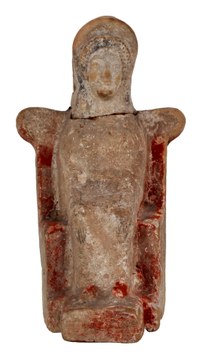Enthroned Women
 |
 |
 |
The type of female robed statuettes on thrones - they are considered to represent deities - was consecrated in sanctuaries and used as grave goods throughout the Mediterranean region, especially in the Late Archaic and Early Classical periods[1]. The feet stand on a stool; the hands rest on the knees. Sometimes the goddess holds a living creature on her lap, a lion, pointing to the periphery of Cybele[2], or a child, which identifies her as Kourotrophos[3]. Rare is a variant with the statuette of a man on his knees[4].
[1] B. Vierneisel-Schlörb, Die figürlichen Terrakotten I. Kerameikos 15 (München 1997) XI.
[2] F. Naumann, Die Ikonographie der Kybele in der Phrygischen und der griechischen Kunst, IstMitt Beih. 28 (Tübingen 1983) 357 no. 542 pl. 39; LIMC VIII (1997) 755 nos. 55. 56. pl. 511 s. v. Kybele (E. Simon).
[3] D. Burr Thompson, Miniature Sculpture from the Athenian Agora (Prnceton 1959) 20; R. Nicholls, Two Groups of attic Terracottas, in: D. Kurtz – M. Sparkes, The Eye of Greece. Festschr. M. Robinson (Cambridge 1982)116 fig. 28 h.
[4] N. Himmelmann, Minima archaeologica (Mainz 1996) 273 f. fig. 147.
[21] A. M. Butyagin, Barbarian Art in the Cities of the Northern Pontic Region, in: Trofimova ibid., 65-69 fig. 9.2 and p. 205 f. nos. 104. 105; P. C. Bol – E. Kotera, Bildwerke aus Terrakotta, Liebieghaus Frankfurt am Main (Melsungen 1986) 227; F. W. Hamdorf, Die figürlichen Terrakotten der Staatlichen Antikensammlungen München 2 (Lindenberg im Allgäu 2014) 664 f.; A. Derewitzky – A. Pavlowsky – E. von Stern (eds.), Das Museum der Kaiserlich Odessaer Gesellschaft für Geschichte und Altertumskunde. Lieferung 1 und 2 Terracotten (Frankfurt a. Main – Odessa 1897 und 1898) 31-35.
[22] Boardman 1981, 297; J. Fornasier – B. Böttger (eds.), Das Bosporanische Reich (Mainz 2002) 10; Trofimova ibid. 147-280.
